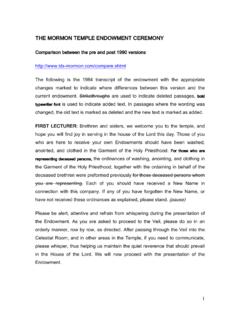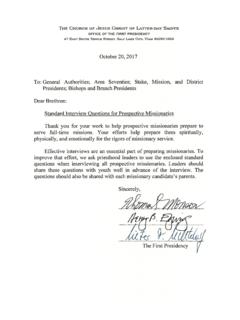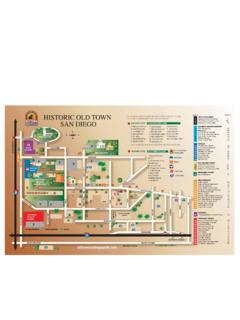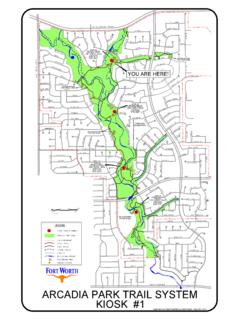Transcription of Nevada Water Facts - pg-tim.com
1 Nevada Water Facts - 1992 Nevada Division of Water Resources Department of Conservation and Natural Resources Water is Nevada 's most precious renewable natural resource and it is our obligation to safeguard this limited resource. A key element in the responsible management of our Water resources is education. Recognizing this need for Water education, the Division of WaterPlanning published the Nevada Water Facts booklet. The following information has been taken from this booklet. NOTE: The Nevada Water Facts booklet was originally published in 1992. As such, some of the information may be dated.
2 The reader is encouraged to contact the Division of Water Resources for more current information. Nevada Water Facts . INTRODUCTION. THE ROLE OF Water IN THE EARLY DEVELOPMENT OF Nevada . Nevada Water LAW. With an arid climate, Nevada has always been dependent upon the successful development of Water resources. During the early development of the State, settlement locations were restricted to areas with readily available Water . Now Nevadans have many more options than these early pioneers. Technologic advances have made it possible to deliver Water to once remote areas, develop a variety of Water sources, and meet the Water needs of a growing population.
3 Water is a primary ingredient for the continued prosperity of Nevada , but its availability is limited. The challenge facing Nevadans is to wisely develop and use our most precious renewable natural resource. With a limited Water supply, conservation and wastewater reclamation become more necessary for responsible Water management. Education of the public about Water and its use is a necessary building block for wise Water management in the future. It is the intent of this booklet to provide the public with a brief introduction to our Water resources. Nevada Water Facts begins with a statewide look at our available Water resources, followed by current and future Water use estimates and related information.
4 In addition, a section has been provided which discusses some of the important Water issues in Nevada . Next, general Water information and selected definitions have been included. Nevada Water Facts . THE ROLE OF Water IN THE EARLY DEVELOPMENT OF Nevada . Water has always played an important role in the history of Nevada . During the 1840's, Nevada assumed the role it was to maintain for several years, a bridge between the rest of the United States and California. The Humboldt River was a natural highway for westward travelers at the same time providing a Water source for the pioneers and their stock.
5 From the Humboldt, the pioneers had the option of following the Carson River or Truckee River routes into California (Elliot, , History of Nevada , 2nd Edition, Revised, University of Nebraska Press, 1987). The Old Spanish Trail served as a route through the southern part of the State. Along the trail travelers encountered las vegas, Spanish for "the meadows." Here, spring Water created an oasis for weary pioneers and the area became a common camping site. In response to the growing traffic towards California, small commercial establishments sprang up along the trails in areas with an adequate Water supply.
6 Along the Carson River segment of the Emigrant Trail, Mormon Station, later renamed Genoa, was founded in 1850 as a trading station and an outpost of the Mormon theocracy (Elliot, , History of Nevada , 2nd Edition, Revised, University of Nebraska Press, 1987) . The first specific mention in historical records of irrigation in Nevada was at Mormon Station. Individual settlers raised irrigated crops to support themselves, and to supply the California gold seekers as they passed through the area. Not long afterwards, a small Mormon outpost at Las Vegas was established as a way station on the road from the Utah settlements to Southern California points.
7 During the summer of 1855, the construction of an irrigation diversion in Las Vegas Creek by the Mormon colonists marked the beginning of organized irrigation in Nevada (State Engineer's Office, Nevada 's Water Resources, Water for Nevada , Report No. 3, Carson City, Nevada , October 1971). Growth fueled by the establishment of stations along the emigrant trails, and the discovery of gold and silver in Nevada , increased the demand for food for people and livestock. Because of the arid nature of the land, irrigation works were necessary to assure adequate food for the mining camps, the freight and stage teams, and the domestic stock.
8 As mining activities in Nevada boomed, so did the thirst for Water for mining and milling operations, and other support developments. Small and large Water development projects mushroomed throughout the State in an attempt to quench the growing demand. Since viable ore bodies were not always discovered in areas with an adequate Water supply, innovative measures were undertaken to move Water from its area of origin to another place of use. Perhaps the best known example of an early transbasin diversion in Nevada is the pipeline constructed to meet the growing Water needs of the Comstock. This hand- riveted pipeline, considered an engineering feat for its time, carried Water from the Tahoe Basin to Virginia City and neighboring towns (Galloway, , "Early Engineering Works Contributory to the Comstock", University of Nevada Bulletin, Vol.)
9 XLI:5, Nevada State Bureau of Mines, 1947). Nevada Water Facts . Nevada Water LAW. The Water in Nevada on the surface and below the ground surface belongs to the people of the State. Entities within the State can apply for the right to use that Water . Nevada Water Law is founded on the doctrine of prior appropriation - "first in time, first in right.". Under the appropriation doctrine, the first user of Water from a Water course acquired a priority right to the use and to the extent of its use (Shamberger, , Evolution of Nevada 's Water Laws, as Related to the Development and Evaluation of the State's Water Resources from 1866 to about 1960, Geological Survey Water Resources Bulletin 46, 1991).
10 Nevada Water Law is set forth in Nevada Revised Statutes (NRS), Chapters 533 and 534. In addition, there are numerous court decisions which have helped define Nevada Water law. The State Engineer is the Water rights administrator and is responsible for the appropriation, adjudication, distribution and management of Water in the State. To carry out these duties he is vested with broad discretionary powers. As part of the duties of the office, the State Engineer reviews applications for new Water rights appropriations. In approving or rejecting an application, the State Engineer considers the following questions as set forth in NRS : 1) is there unappropriated Water in the proposed source?







